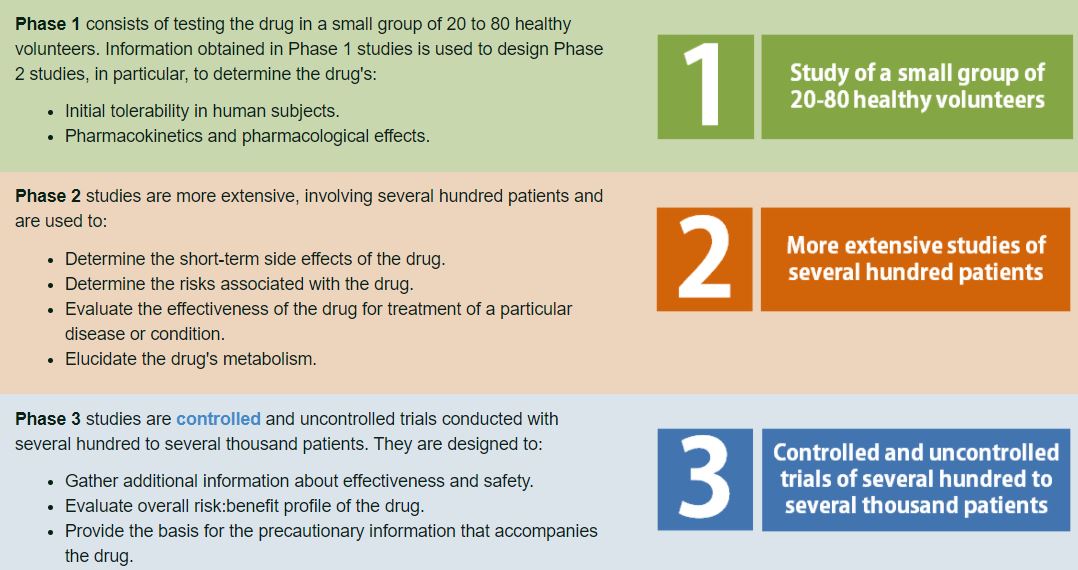Clinical Investigations and Other Types of Human Data
Several approaches exist for determining how toxic drugs and consumer products are to humans.
For Drugs
For Drugs
|
The focus of this section is on the U.S. Food and Drug Administration (FDA), but regulatory agencies worldwide have very similar approaches. The main methods of determining the toxicity of drugs to humans are:
|
Figure 1. Drugs can be toxic to humans
(Image Source: iStock Photos, ©) |
|
Clinical Investigations
Clinical investigations are a component of Investigational New Drug Applications (INDs) submitted to the FDA. Clinical investigations are conducted only after a minimal battery of nonclinical laboratory studies has been completed. Toxicity studies using human subjects require strict ethical considerations. They are primarily conducted for new pharmaceutical applications submitted to the FDA for approval. Generally, toxicity found in animal studies occurs with similar incidence and severity in humans. Differences sometimes occur, thus clinical tests with humans are needed to confirm the results of nonclinical laboratory studies. FDA clinical investigations are conducted in three phases, as outlined below. |
Figure 2. Portion of the Investigational New Drug Application (IND)
(Image Source: FDA) |
For Consumer Products
Health-related data for a chemical in a consumer product (and for the consumer product itself for the human studies) can come from the following types of studies:
Health-related data for a chemical in a consumer product (and for the consumer product itself for the human studies) can come from the following types of studies:
- In silico data — from computer programs that estimate toxic properties based on data for similar chemicals, and/or from the physical chemical properties.
- In vitro data — from the results of alternatives to animal tests, such as from cell cultures used to assess the potential for eye or skin irritation.
- Animal (toxicological) study data — for example, from studies that assessed eye or skin irritation potential.
- Human data – from studies conducted before (premarketing) and after (postmarketing) a product had been sold to consumers. More specifically, from:
- Premarketing clinical studies, such as from patch tests to assess skin irritation potential.
- Premarketing "controlled use" studies that are designed to assess the skin effects from using a new type of personal care product.
- Postmarketing studies conducted by physicians or dermatologists, such as testing a diagnostic patch with their patients.
- Postmarketing epidemiological studies, including studies developed by Poison Control Centers, companies, and academia that look at the "real world" health reports of effects associated with consumer use of a product.
Figure 3. Toxicologists in a lab, using a computer for research
(Image Source: iStock Photos, ©)
(Image Source: iStock Photos, ©)
|
Did you know?
Bisphenol A (BPA) and phthalates are chemicals that have been widely found in consumer products. BPA has been used in some food can linings, polycarbonate food and beverage containers, tooth sealants applied to dentists, and even in cash register receipts! Examples of potential exposures to BPA include eating or drinking foods or liquids from those containers, and skin exposures from handing the cash register receipts. Workers involved in making products with BPA can be exposed during production. Often called plasticizers, phthalates are used to make plastics more flexible. Some phthalates are used as solvents. They can be found in vinyl flooring and shower curtains, children's toys, personal care products, and as contaminants in the food supply. As with BPA, exposures can come from many sources. Toxicologists and others are still assessing the full extent of the potential impacts on health. Studies suggest that BPA and phthalates affect the reproductive system, impacting how hormones such as estrogen and testosterone work in the body. The impact of fetal or early childhood exposures is still being assessed. Because of the ubiquity of the possible products containing these chemicals, thorough assessments of potential exposures, toxicities, and potential substitutes are essential. |
Figure 4. Plastic food and beverage containers are common sources of BPA and phthalates in consumer products
(Image Source: iStock Photos, ©) |






